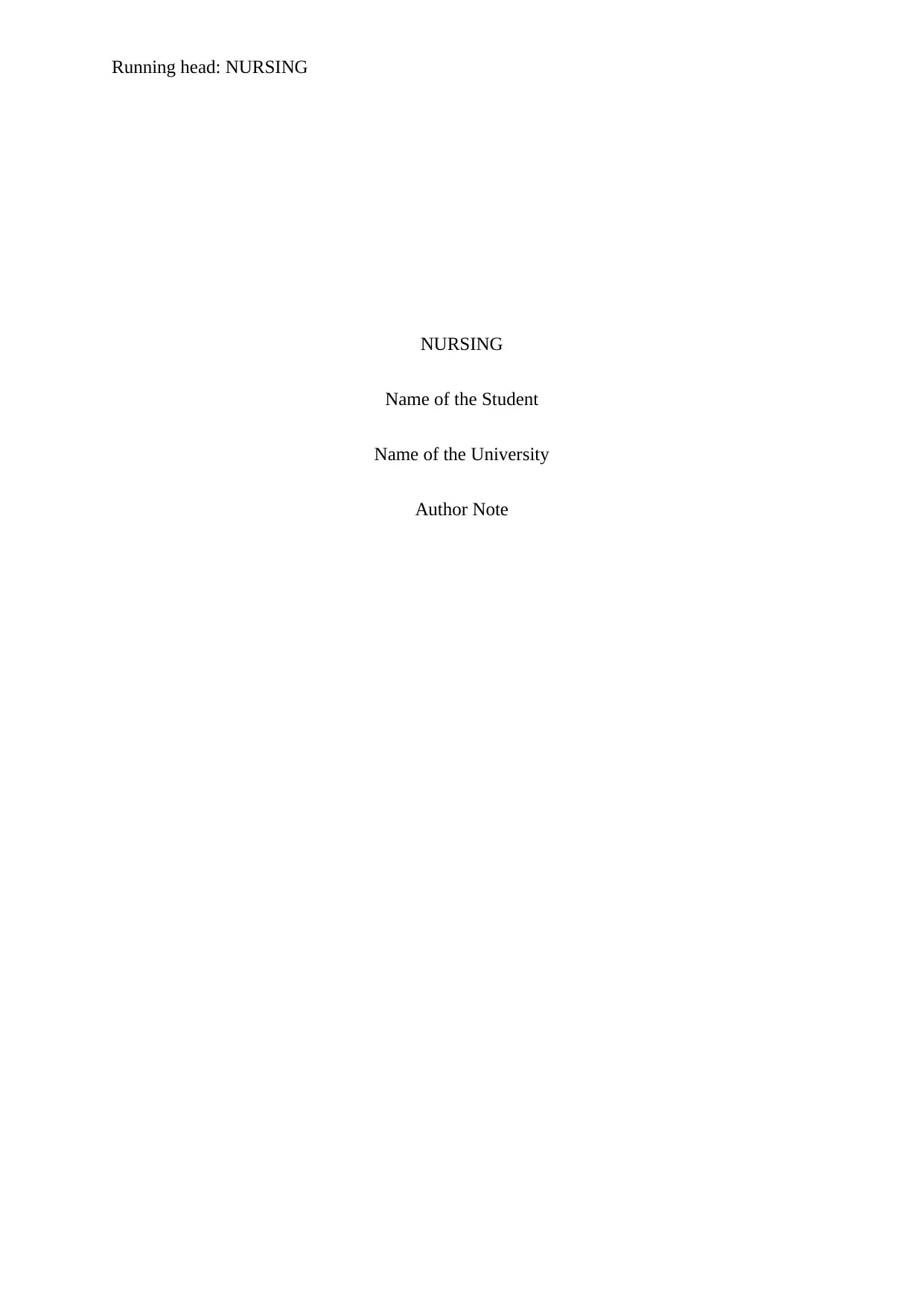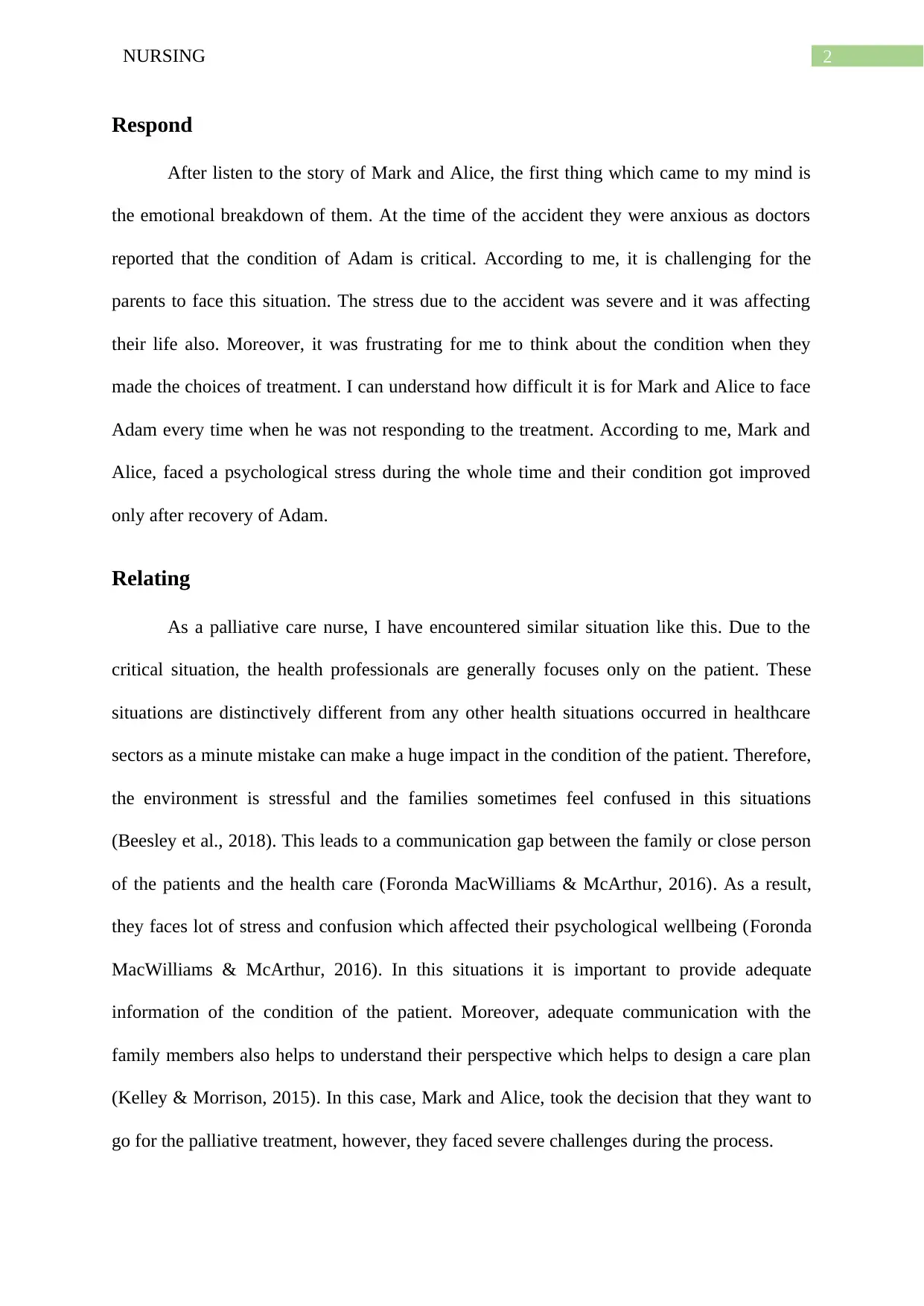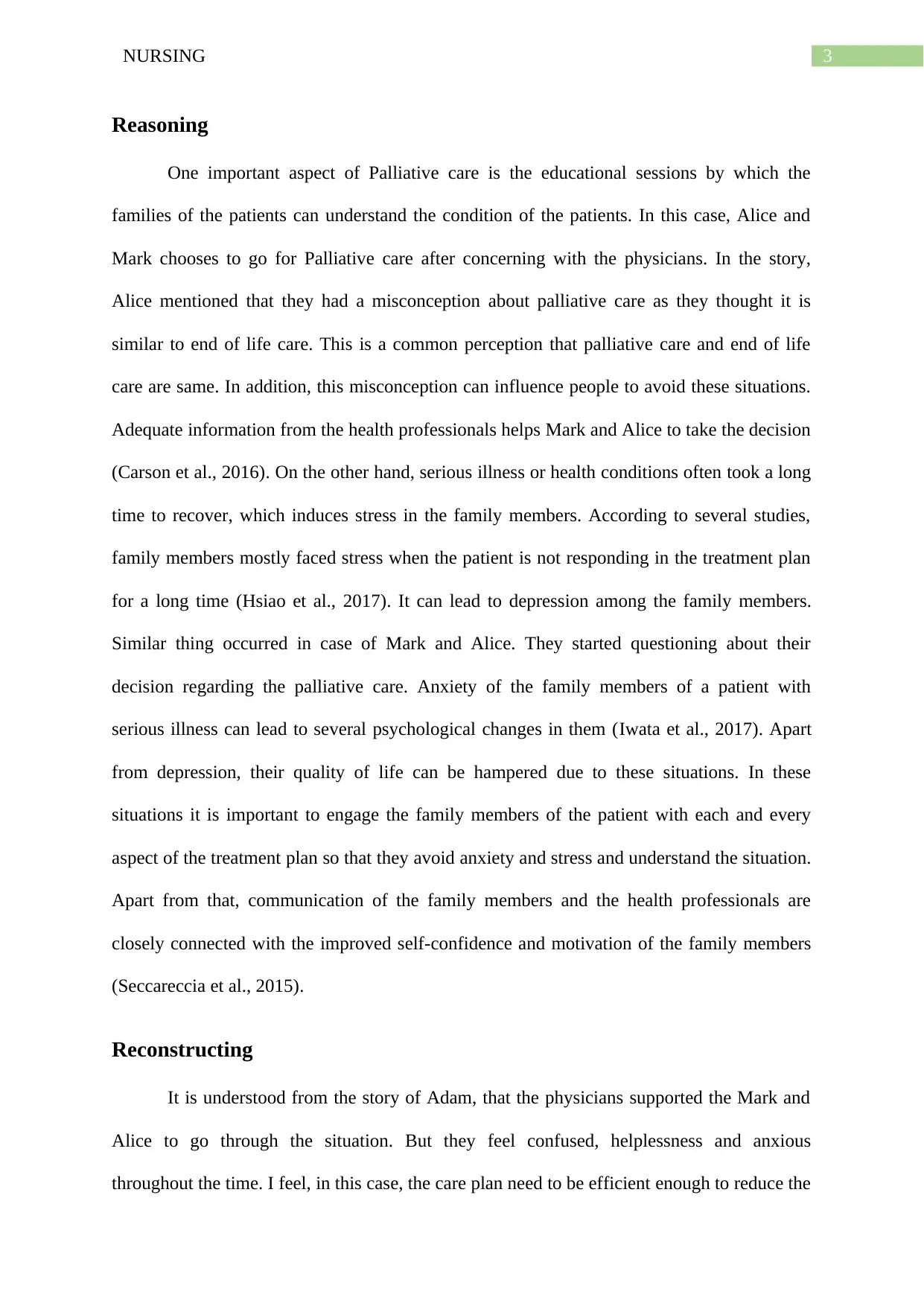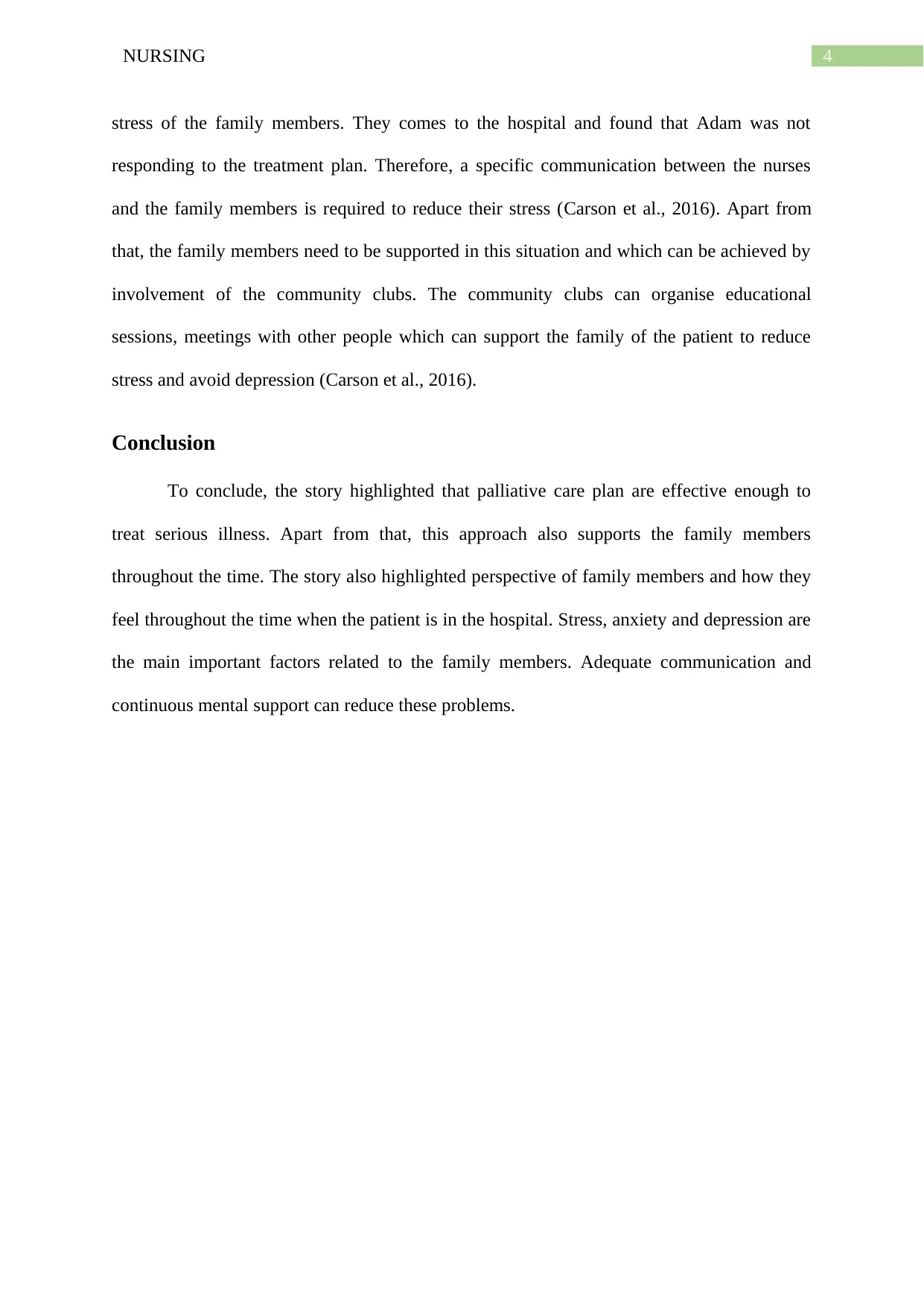University Nursing Report: Family Perspective on Palliative Care
VerifiedAdded on 2022/10/10
|7
|1613
|207
Report
AI Summary
This reflective report examines the family's perspective on palliative care, drawing from a story about a family whose son suffered a severe accident. The report uses the framework of Reporting, Responding, Relating, Reasoning, and Reconstructing to analyze the family's experience with their son's illness. It highlights the parents' confusion, stress, and misconceptions about palliative care, as well as their emotional journey throughout their son's treatment. The report also connects the story to the nurse's professional experiences, emphasizing the importance of communication, education, and support for families facing similar situations. The report incorporates scientific literature to support its arguments, focusing on the psychological impact of serious illness on family members and the role of palliative care in addressing their needs. The conclusion underscores the effectiveness of palliative care in managing serious illnesses and supporting families, emphasizing the need for clear communication and mental health support to reduce stress, anxiety, and depression.

Running head: NURSING
NURSING
Name of the Student
Name of the University
Author Note
NURSING
Name of the Student
Name of the University
Author Note
Paraphrase This Document
Need a fresh take? Get an instant paraphrase of this document with our AI Paraphraser

1NURSING
Introduction
Palliative care refers to a specially designed care plan for people with a serious
illness. In a broad perspective the care plan not only improves the quality of lives of the
patients but also supports their families in this time (Kelley & Morrison, 2015). This is a
reflective report describing the perception of palliative care from the family. The story is
taken from youtube.com (https://www.youtube.com/watch?v=xfmhPd8jROM). The report is
divided into five different stages to such as Reporting, Responding, Relating, Reasoning and
Reconstructing. Moreover the report is supported with scientific literatures retrieved from
Google scholar and PubMed.
Reporting
The report describes the perspective of Mark and Alice, whose son Adam had a car
accident and his condition was severe. As per the story, Adam’s condition was severe and his
chances of living was very low. One major thing highlighted in this story is the confusion and
stress of Mark and Alice, as they did not know anything about the condition of Adam after
several days. His parents need to take the decision whether they want to continue the
treatment or not. According to Alice, she knows about the concept of Palliative care, but she
has a misconception which indicates palliative care and end of life care are same and it makes
them anxious. However, they choose to go for palliative care for Adam. After several days of
treatment, there was no significant change in Adam’s condition which negatively affected the
psychological level of his parents. Finally, after seven weeks Adam responded on the
medication and later he goes through continuous improvement.
Introduction
Palliative care refers to a specially designed care plan for people with a serious
illness. In a broad perspective the care plan not only improves the quality of lives of the
patients but also supports their families in this time (Kelley & Morrison, 2015). This is a
reflective report describing the perception of palliative care from the family. The story is
taken from youtube.com (https://www.youtube.com/watch?v=xfmhPd8jROM). The report is
divided into five different stages to such as Reporting, Responding, Relating, Reasoning and
Reconstructing. Moreover the report is supported with scientific literatures retrieved from
Google scholar and PubMed.
Reporting
The report describes the perspective of Mark and Alice, whose son Adam had a car
accident and his condition was severe. As per the story, Adam’s condition was severe and his
chances of living was very low. One major thing highlighted in this story is the confusion and
stress of Mark and Alice, as they did not know anything about the condition of Adam after
several days. His parents need to take the decision whether they want to continue the
treatment or not. According to Alice, she knows about the concept of Palliative care, but she
has a misconception which indicates palliative care and end of life care are same and it makes
them anxious. However, they choose to go for palliative care for Adam. After several days of
treatment, there was no significant change in Adam’s condition which negatively affected the
psychological level of his parents. Finally, after seven weeks Adam responded on the
medication and later he goes through continuous improvement.

2NURSING
Respond
After listen to the story of Mark and Alice, the first thing which came to my mind is
the emotional breakdown of them. At the time of the accident they were anxious as doctors
reported that the condition of Adam is critical. According to me, it is challenging for the
parents to face this situation. The stress due to the accident was severe and it was affecting
their life also. Moreover, it was frustrating for me to think about the condition when they
made the choices of treatment. I can understand how difficult it is for Mark and Alice to face
Adam every time when he was not responding to the treatment. According to me, Mark and
Alice, faced a psychological stress during the whole time and their condition got improved
only after recovery of Adam.
Relating
As a palliative care nurse, I have encountered similar situation like this. Due to the
critical situation, the health professionals are generally focuses only on the patient. These
situations are distinctively different from any other health situations occurred in healthcare
sectors as a minute mistake can make a huge impact in the condition of the patient. Therefore,
the environment is stressful and the families sometimes feel confused in this situations
(Beesley et al., 2018). This leads to a communication gap between the family or close person
of the patients and the health care (Foronda MacWilliams & McArthur, 2016). As a result,
they faces lot of stress and confusion which affected their psychological wellbeing (Foronda
MacWilliams & McArthur, 2016). In this situations it is important to provide adequate
information of the condition of the patient. Moreover, adequate communication with the
family members also helps to understand their perspective which helps to design a care plan
(Kelley & Morrison, 2015). In this case, Mark and Alice, took the decision that they want to
go for the palliative treatment, however, they faced severe challenges during the process.
Respond
After listen to the story of Mark and Alice, the first thing which came to my mind is
the emotional breakdown of them. At the time of the accident they were anxious as doctors
reported that the condition of Adam is critical. According to me, it is challenging for the
parents to face this situation. The stress due to the accident was severe and it was affecting
their life also. Moreover, it was frustrating for me to think about the condition when they
made the choices of treatment. I can understand how difficult it is for Mark and Alice to face
Adam every time when he was not responding to the treatment. According to me, Mark and
Alice, faced a psychological stress during the whole time and their condition got improved
only after recovery of Adam.
Relating
As a palliative care nurse, I have encountered similar situation like this. Due to the
critical situation, the health professionals are generally focuses only on the patient. These
situations are distinctively different from any other health situations occurred in healthcare
sectors as a minute mistake can make a huge impact in the condition of the patient. Therefore,
the environment is stressful and the families sometimes feel confused in this situations
(Beesley et al., 2018). This leads to a communication gap between the family or close person
of the patients and the health care (Foronda MacWilliams & McArthur, 2016). As a result,
they faces lot of stress and confusion which affected their psychological wellbeing (Foronda
MacWilliams & McArthur, 2016). In this situations it is important to provide adequate
information of the condition of the patient. Moreover, adequate communication with the
family members also helps to understand their perspective which helps to design a care plan
(Kelley & Morrison, 2015). In this case, Mark and Alice, took the decision that they want to
go for the palliative treatment, however, they faced severe challenges during the process.
⊘ This is a preview!⊘
Do you want full access?
Subscribe today to unlock all pages.

Trusted by 1+ million students worldwide

3NURSING
Reasoning
One important aspect of Palliative care is the educational sessions by which the
families of the patients can understand the condition of the patients. In this case, Alice and
Mark chooses to go for Palliative care after concerning with the physicians. In the story,
Alice mentioned that they had a misconception about palliative care as they thought it is
similar to end of life care. This is a common perception that palliative care and end of life
care are same. In addition, this misconception can influence people to avoid these situations.
Adequate information from the health professionals helps Mark and Alice to take the decision
(Carson et al., 2016). On the other hand, serious illness or health conditions often took a long
time to recover, which induces stress in the family members. According to several studies,
family members mostly faced stress when the patient is not responding in the treatment plan
for a long time (Hsiao et al., 2017). It can lead to depression among the family members.
Similar thing occurred in case of Mark and Alice. They started questioning about their
decision regarding the palliative care. Anxiety of the family members of a patient with
serious illness can lead to several psychological changes in them (Iwata et al., 2017). Apart
from depression, their quality of life can be hampered due to these situations. In these
situations it is important to engage the family members of the patient with each and every
aspect of the treatment plan so that they avoid anxiety and stress and understand the situation.
Apart from that, communication of the family members and the health professionals are
closely connected with the improved self-confidence and motivation of the family members
(Seccareccia et al., 2015).
Reconstructing
It is understood from the story of Adam, that the physicians supported the Mark and
Alice to go through the situation. But they feel confused, helplessness and anxious
throughout the time. I feel, in this case, the care plan need to be efficient enough to reduce the
Reasoning
One important aspect of Palliative care is the educational sessions by which the
families of the patients can understand the condition of the patients. In this case, Alice and
Mark chooses to go for Palliative care after concerning with the physicians. In the story,
Alice mentioned that they had a misconception about palliative care as they thought it is
similar to end of life care. This is a common perception that palliative care and end of life
care are same. In addition, this misconception can influence people to avoid these situations.
Adequate information from the health professionals helps Mark and Alice to take the decision
(Carson et al., 2016). On the other hand, serious illness or health conditions often took a long
time to recover, which induces stress in the family members. According to several studies,
family members mostly faced stress when the patient is not responding in the treatment plan
for a long time (Hsiao et al., 2017). It can lead to depression among the family members.
Similar thing occurred in case of Mark and Alice. They started questioning about their
decision regarding the palliative care. Anxiety of the family members of a patient with
serious illness can lead to several psychological changes in them (Iwata et al., 2017). Apart
from depression, their quality of life can be hampered due to these situations. In these
situations it is important to engage the family members of the patient with each and every
aspect of the treatment plan so that they avoid anxiety and stress and understand the situation.
Apart from that, communication of the family members and the health professionals are
closely connected with the improved self-confidence and motivation of the family members
(Seccareccia et al., 2015).
Reconstructing
It is understood from the story of Adam, that the physicians supported the Mark and
Alice to go through the situation. But they feel confused, helplessness and anxious
throughout the time. I feel, in this case, the care plan need to be efficient enough to reduce the
Paraphrase This Document
Need a fresh take? Get an instant paraphrase of this document with our AI Paraphraser

4NURSING
stress of the family members. They comes to the hospital and found that Adam was not
responding to the treatment plan. Therefore, a specific communication between the nurses
and the family members is required to reduce their stress (Carson et al., 2016). Apart from
that, the family members need to be supported in this situation and which can be achieved by
involvement of the community clubs. The community clubs can organise educational
sessions, meetings with other people which can support the family of the patient to reduce
stress and avoid depression (Carson et al., 2016).
Conclusion
To conclude, the story highlighted that palliative care plan are effective enough to
treat serious illness. Apart from that, this approach also supports the family members
throughout the time. The story also highlighted perspective of family members and how they
feel throughout the time when the patient is in the hospital. Stress, anxiety and depression are
the main important factors related to the family members. Adequate communication and
continuous mental support can reduce these problems.
stress of the family members. They comes to the hospital and found that Adam was not
responding to the treatment plan. Therefore, a specific communication between the nurses
and the family members is required to reduce their stress (Carson et al., 2016). Apart from
that, the family members need to be supported in this situation and which can be achieved by
involvement of the community clubs. The community clubs can organise educational
sessions, meetings with other people which can support the family of the patient to reduce
stress and avoid depression (Carson et al., 2016).
Conclusion
To conclude, the story highlighted that palliative care plan are effective enough to
treat serious illness. Apart from that, this approach also supports the family members
throughout the time. The story also highlighted perspective of family members and how they
feel throughout the time when the patient is in the hospital. Stress, anxiety and depression are
the main important factors related to the family members. Adequate communication and
continuous mental support can reduce these problems.

5NURSING
Reference
Beesley, S. J., Hopkins, R. O., Holt-Lunstad, J., Wilson, E. L., Butler, J., Kuttler, K. G., ... &
Hirshberg, E. L. (2018). Acute physiologic stress and subsequent anxiety among
family members of ICU patients. Critical care medicine, 46(2), 229.
Carson, S. S., Cox, C. E., Wallenstein, S., Hanson, L. C., Danis, M., Tulsky, J. A., ... &
Nelson, J. E. (2016). Effect of palliative care–led meetings for families of patients
with chronic critical illness: a randomized clinical trial. Jama, 316(1), 51-62.
Foronda, C., MacWilliams, B., & McArthur, E. (2016). Interprofessional communication in
healthcare: An integrative review. Nurse education in practice, 19, 36-40.
Hsiao, P. R., Redley, B., Hsiao, Y. C., Lin, C. C., Han, C. Y., & Lin, H. R. (2017). Family
needs of critically ill patients in the emergency department. International emergency
nursing, 30, 3-8.
Iwata, M., Han, S., Hays, R., & Doorenbos, A. Z. (2019). Predictors of Depression and
Anxiety in Family Members 3 Months After Child’s Admission to a Pediatric ICU.
American Journal of Hospice and Palliative Medicine®, 1049909119859517.
Kelley, A. S., & Morrison, R. S. (2015). Palliative care for the seriously ill. New England
Journal of Medicine, 373(8), 747-755.
Seccareccia, D., Wentlandt, K., Kevork, N., Workentin, K., Blacker, S., Gagliese, L., ... &
Zimmermann, C. (2015). Communication and quality of care on palliative care units:
a qualitative study. Journal of palliative medicine, 18(9), 758-764.
Reference
Beesley, S. J., Hopkins, R. O., Holt-Lunstad, J., Wilson, E. L., Butler, J., Kuttler, K. G., ... &
Hirshberg, E. L. (2018). Acute physiologic stress and subsequent anxiety among
family members of ICU patients. Critical care medicine, 46(2), 229.
Carson, S. S., Cox, C. E., Wallenstein, S., Hanson, L. C., Danis, M., Tulsky, J. A., ... &
Nelson, J. E. (2016). Effect of palliative care–led meetings for families of patients
with chronic critical illness: a randomized clinical trial. Jama, 316(1), 51-62.
Foronda, C., MacWilliams, B., & McArthur, E. (2016). Interprofessional communication in
healthcare: An integrative review. Nurse education in practice, 19, 36-40.
Hsiao, P. R., Redley, B., Hsiao, Y. C., Lin, C. C., Han, C. Y., & Lin, H. R. (2017). Family
needs of critically ill patients in the emergency department. International emergency
nursing, 30, 3-8.
Iwata, M., Han, S., Hays, R., & Doorenbos, A. Z. (2019). Predictors of Depression and
Anxiety in Family Members 3 Months After Child’s Admission to a Pediatric ICU.
American Journal of Hospice and Palliative Medicine®, 1049909119859517.
Kelley, A. S., & Morrison, R. S. (2015). Palliative care for the seriously ill. New England
Journal of Medicine, 373(8), 747-755.
Seccareccia, D., Wentlandt, K., Kevork, N., Workentin, K., Blacker, S., Gagliese, L., ... &
Zimmermann, C. (2015). Communication and quality of care on palliative care units:
a qualitative study. Journal of palliative medicine, 18(9), 758-764.
⊘ This is a preview!⊘
Do you want full access?
Subscribe today to unlock all pages.

Trusted by 1+ million students worldwide

6NURSING
1 out of 7
Related Documents
Your All-in-One AI-Powered Toolkit for Academic Success.
+13062052269
info@desklib.com
Available 24*7 on WhatsApp / Email
![[object Object]](/_next/static/media/star-bottom.7253800d.svg)
Unlock your academic potential
Copyright © 2020–2025 A2Z Services. All Rights Reserved. Developed and managed by ZUCOL.





